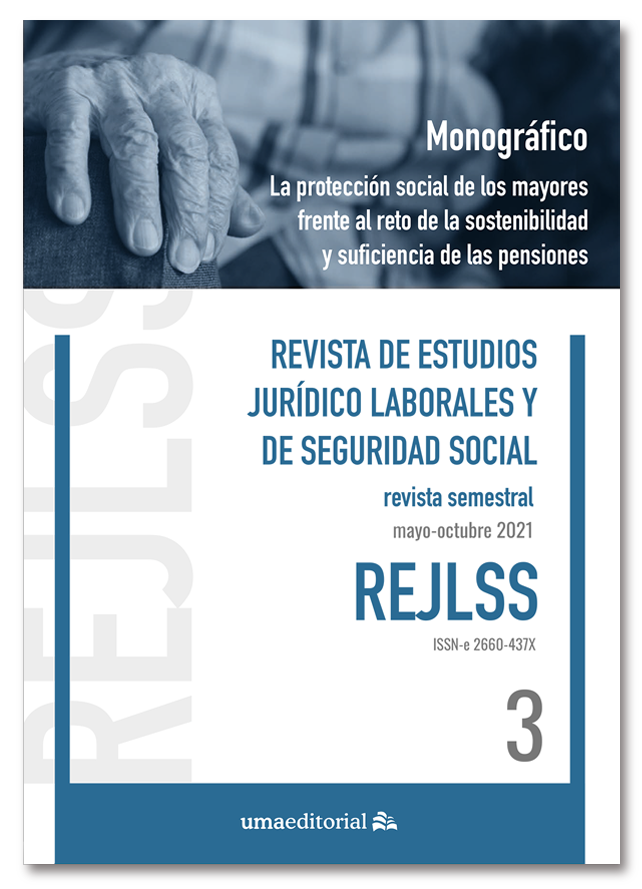Reseña de “Beneficiarios de la pensión de viudedad” (Menéndez Sebastián, P., Thomson Reuters Aranzadi, Cizur Menor, 2021)
DOI:
https://doi.org/10.24310/rejlss.vi3.13545Keywords:
Reseña, Beneficiarios de la pensión de viudedadAbstract
Es por todos conocido que la pensión de viudedad constituye una prestación de la Seguridad Social orientada claramente a proteger a la familia. Y es que quizá, el mandato constitucional proclamado en el art. 39 CE y dirigido a los poderes públicos, adopta en la pensión de viudedad una de sus manifestaciones más contundentes.
Pero no solo eso. No se puede negar tampoco que, aunque ya totalmente superada su configuración histórica como derecho exclusivamente femenino, los datos estadísticos se ocupan cada año de confirmar que esta prestación no deja de ser hoy en día una prestación típicamente femenina, al ser sustancialmente mucho más numeroso el colectivo de beneficiarias mujeres que el de los varones. En concreto hoy en día las viudas constituyen en España más del 90% de las beneficiarias y los viudos, apenas representan el 10% del total. De esta forma, razones demográficas y sociológicas confluyen y convierten a la pensión de viudedad en un referente obligado a la hora de emprender el estudio del Derecho del Trabajo y de la Seguridad Social con perspectiva de género. Por esta razón, aspectos tales como los requisitos de acceso a la prestación exigidos tanto al causante como al cónyuge supérstite, o las reglas que rigen la cuantificación del importe al que ascenderá la citada pensión, se convierten en piezas clave a la hora de valorar el nivel de protección social que recibe la mujer en nuestro ordenamiento jurídico y de combatir los factores que siguen provocando la brecha en salarios y pensiones que, todavía en pleno siglo XXI, sigue lastrando la igualdad efectiva entre mujeres y hombres.
Downloads
Metrics
Downloads
Published
How to Cite
Issue
Section
License
In the Revista de Estudios Juridico Laborales y de Seguridad Social (REJLSS) we are clearly committed to a policy of open access to scientific knowledge (See Berlin Declaration).
Those authors who have publications with this journal accept the following terms:
This journal provides immediate free access to its content under the principle of making research freely available to the public. All the contents published in the REJLSS are subject to the Creative Commons license
Attribution-NonCommercial-NoDerivatives 4.0 International (CC BY-NC-ND 4.0)
Copyrights are of two kinds: moral and patrimonial. Moral rights are perpetual, inalienable, non-transferable, inalienable, unattachable and imprescriptible prerogatives. In accordance with Spanish copyright legislation, the authors who publish in REJLSS retain the moral right over their work, as well as the ownership of the patrimonial right, which will be transferred to the University of Malaga for its dissemination in open access.
The patrimonial rights, refer to the benefits that are obtained by the use or disclosure of the works. REJLSS is published in open access and is exclusively authorized to perform or authorize by any means the use, distribution, dissemination, reproduction, adaptation, translation or transformation of the work.
It is the responsibility of the authors to obtain the necessary permissions of the images that are subject to copyright.
Authors whose contributions are accepted for publication in this journal retain the non-exclusive right to use their contributions for academic, research and educational purposes, including self-archiving or depositing in open access repositories of any kind.
The electronic edition of this magazine is edited by the Editorial of the University of Malaga (UmaEditorial), being necessary to cite the origin in any partial or total reproduction.
The authors may adopt other non-exclusive license agreements for the distribution of the version of the published work (eg: deposit it in an institutional telematic archive or publish it in a monographic volume) provided that the initial publication is indicated in this magazine.
Authors are allowed and recommended to disseminate their work through the Internet (eg, in institutional telematic archives or on their website) before and during the submission process, which can produce interesting exchanges and increase citations of the published work.






19.png)
